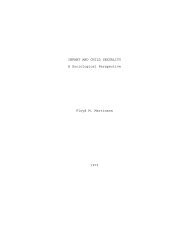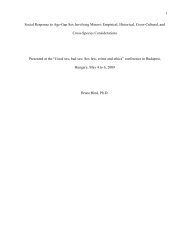Kapitel 2 - Ipce
Kapitel 2 - Ipce
Kapitel 2 - Ipce
Sie wollen auch ein ePaper? Erhöhen Sie die Reichweite Ihrer Titel.
YUMPU macht aus Druck-PDFs automatisch weboptimierte ePaper, die Google liebt.
25<br />
„The Commission observes that this is an argument traditionally invoked to justify the discrimination of children<br />
born out of wedlock" (ECmHR Inze 1987, p. 27, § 94)<br />
26<br />
App. 9214/80, 9473/81, 9474/81, 6 Eur.Hum.Rts.Rep., 41, zitiert nach Helfer (1990, p. 1071/Anm. 188)<br />
27<br />
„Admittedly, the tranquillity of legitimate families may sometimes be disturbed if an illegitimate child is included,<br />
in the eyes of the law, in his mother's family on the same footing as a child born out of wedlock, but this is not a<br />
motive that justifies depriving the former child of fundamental rights" (ECtHR, Marckx 1979, 48)<br />
28<br />
„it is exactly against the traditional contempt of all kinds of minorities that Art. 14 of the Convention offers<br />
protection" (ECmHR, Inze 1987, 88); „the argument relating to the convictions of the rural population merely<br />
reflects the traditional outlook" (ECtHR, Inze 1987, 44)<br />
vgl. daß das deutsche Bundesverfassungsgericht als Grundlage für Ungleichbehandlungen zwischen Mann und Frau<br />
weder die „jahrhundertealte Überlieferung" noch die herausgebildete Arbeitsteilung akzeptiert, wonach „auf einem<br />
Bauernhof im allgemeinen dem Manne die Außenwirtschaft und auch regelmäßig die Planung und Leitung des<br />
Betriebes obliegt, während die Frau die Innenwirtschaft mit den Arbeiten in Haushalt, Stall und Garten besorgt"<br />
(BVerfGE 15, 337, 342 zitiert nach Hofmann 1986, S. 46/Anm. 118)<br />
vgl. auch: „Diskriminierung ist [...] Differenzierung, die in öffentlichen Angelegenheiten bewußt tatsächlich<br />
vorliegende Unterschiede zwischen Menschen hervorhebt [...] die Diskriminierung [ist] sachlich nicht zu<br />
rechtfertigen" (Ermacora 1971, S. 233)<br />
29<br />
„the Court is not persuaded by the Government's arguments. Most of them are based on general and abstract<br />
considerations" (ECtHR, Inze 1987, § 43)<br />
30<br />
„such an attitude is not a general feature of the relationship between unmarried mothers and their children"<br />
(ECtHR, Marckx 1979, § 39)<br />
31<br />
ECmHR, Inze 1987 (§ 95)<br />
32<br />
„the Government's arguments are not convincing" (ECtHR, Abdulaziz et al. 1985, 79). Dies obwohl das Gericht<br />
festhält, daß nur 41% der einwandernden indischen Frauen im Gegensatz zu 86% der einwandernden indischen<br />
Männer erwerbstätig sind („not convinced that the difference [...] is sufficiently important to justify the difference of<br />
treatment"; ebendort).<br />
33<br />
„The Court accepts that the 1980 Rules also had, as the Government stated, the aim of advancing public<br />
tranquillity. However, it is not persuaded that this aim was served by the distinction drawn in those rules" (ECtHR,<br />
Abdulaziz et al. 1985, § 81)<br />
34<br />
ECtHR, Marckx 1979 (§ 42)<br />
35<br />
„the aim of the legislation in question could have been achieved by applying criteria other than that based on birth<br />
in or out of wedlock" (ECtHR, Inze 1987, § 44);<br />
36 Ermacora (1988, S. 79)<br />
37<br />
Die zentrale Bedeutung des Gleichheitssatzes ergibt sich auch daraus, daß das B-VG 1920 nur zwei Grundrechte<br />
enthält. Eines davon stellt der Gleichheitssatz dar.<br />
38<br />
Ursprünglich zielte der Gleichheitssatz auf die Abschaffung der Standesvorrechte des Adels. Von dieser<br />
Stoßrichtung der punktuellen Entprivilegisierung hat er sich aber mit der Zeit zu einer allgemeinen<br />
Rechtsanwendungsgleichheit entwickelt.<br />
(vgl. hiezu näher Kiemenz 1987 und Rack/Wimmer 1983)

















